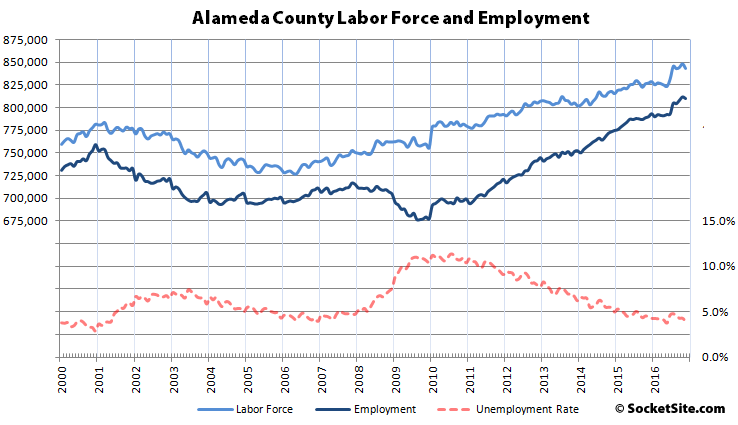While the unemployment rate in San Francisco ticked up to 3.4 percent in October, it was driven by an increase in the size of the labor force and the number of people living in the city with a job actually increased by 2,400 to a record 548,900.
And in an opposite move, while the unemployment rate in San Francisco has now dropped to 3.1 percent, it was driven by 2,300 people leaving the labor force in November and employment has dipped by 700 to 547,300.
That being said, there are still 81,800 more people living in San Francisco with paychecks than there were at the end of 2000, an increase of 110,600 since January of 2010 and 14,300 more than at the same time last year.
In Alameda County, which includes Oakland, while the unemployment rate dropped to 4.0 percent, employment dipped by 1,800 in November to 810,100 but is still 20,100 higher than at the same time last year, an increase of 118,100 employed residents since January 2010.
And while the unemployment rate across the greater East Bay dropped to 4.0 percent, employment dipped by 3,400 to 1,348,400.
Up north, employment in Marin County slipped by 500 to 141,000, while the unemployment rate dropped to 3.0 percent. And down in the valley, while the unemployment rate in San Mateo County dropped to 2.8 percent, employment slipped by 700 to 442,300. But in Santa Clara County, the unemployment rate dropped to 3.5 percent and employment ticked up by 1,000 to 1,020,300.


It’s interesting that SF has gained essentially the same number of employees as Alameda County since the depth of the great recession. It used to be that year after year jobs were more dispersed in the region, but this boom has been unique in the concentration of employment growth in the City.
Except this isn’t “employment growth in the City”- as you’re defining it – it’s where employed people live. It may of course be true what you’re saying (about place of work), but this data set doesn’t actually show that.
Socketsite: learn to cite a source! How about starting a sentence with “according to”, so readers can dig in more?
According to the data we collected from the State of California’s Labor Market Information Division and crunched.